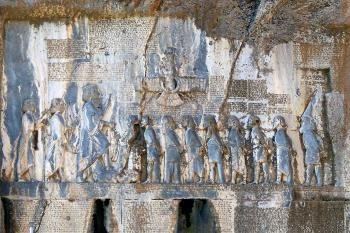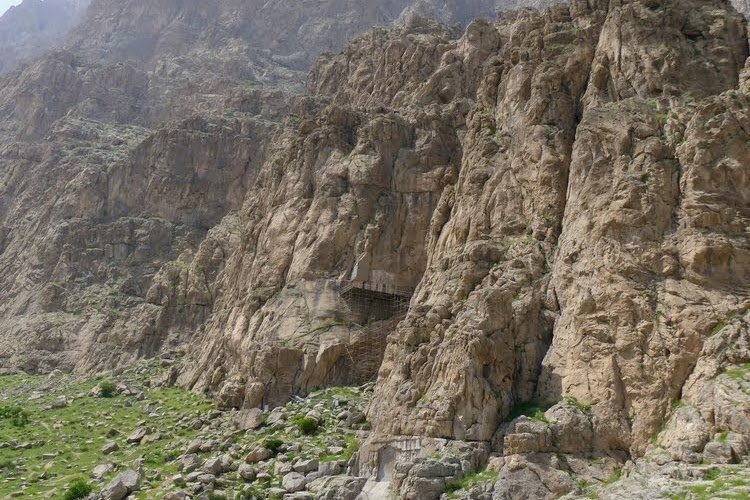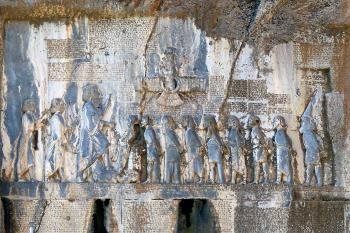Iran
Bisotun
Bisotun is an archaeological site located along a historical trade route, with the Bisotun Inscription as its primary monument.
The text was written in 521 BCE by Darius I the Great when he conquered the Persian throne. The inscription is in three languages, Elamite, Babylonian and Old Persian, and was crucial in the decipherment of cuneiform script. It is illustrated with bas-reliefs depicting Darius I and other figures.
Community Perspective: In the past, it was possible to climb up to the inscription (Massimo managed to do so in 2012), but nowadays it is covered in scaffolding and you need to stand a long way back to obtain a relatively obscured view (according to Solivagant in 2016; he also has described other components of the site).
Site Info
Official Information
- Full Name
- Bisotun (ID: 1222)
- Country
- Iran
- Status
-
Inscribed 2006
Site history
History of Bisotun
- 2006: Inscribed
- Inscribed
- Type
- Cultural
- Criteria
- ii
- iii
Links
- UNESCO
- whc.unesco.org
- Official
-
- visitiran.ir — Visit Iran
- Related
-
- en.wikipedia.org — Wikipedia on Bisotun
All Links
UNESCO.org
- whc.unesco.org — whc.unesco.org/
Official Website
- visitiran.ir — Visit Iran
Related Resources
- en.wikipedia.org — Wikipedia on Bisotun
News Article
- Dec. 1, 2025 tehrantimes.com — Groundbreaking research reveals two-thirds of Babylonian Bisotun inscription may be lost
- March 26, 2010 cais-soas.com — Archaeologists will carry out an archaeological research on Bistun to unearth a settlement date back to the third Iranian dynasty, the Arsacids
- July 27, 2008 tehrantimes.com — Tourist facilities and museum planned for Bisotun
- March 14, 2007 chnpress.com — By constructing a fountain in vicinity of Bisotun, the municipality of Bisotun has violated the cultural landscape of the eighth Iranian world heritage site.
- Oct. 22, 2006 payvand.com — Ignorance to Ruin Bisotun's Inscription
- Sept. 23, 2006 mehrnews.ir — Court halts petrochemical co. operations near ancient Bisotun
- Aug. 10, 2006 mehrnews.ir — Industrial town to invade perimeter of Bisotun
- July 22, 2006 isna.ir — UNESCO Recognizes Bistoon as World Cultural Heritage
Community Information
- Community Category
- Archaeological site: Near Eastern
Travel Information
Exact locations inscribed twice (or more)
The Bisotun caravanserai is also included within the World Heritage property of the Persian …
Red Zone Travel Advisory
Recent Connections
-
Curse Inscriptions
"If you conceal this declaration and do…
-
Hotels in Historic Buildings
"Bisotun Caravanserai was reconstructed…
-
Exact locations inscribed twice (or more)
The Bisotun caravanserai is also includ…
Connections of Bisotun
- Geography
-
-
Kurdistan
In Iranian Kurdistan
-
- Trivia
-
-
Famous Love Stories
Shirin and Fahrad
See www.livius.org
-
Hotels in Historic Buildings
"Bisotun Caravanserai was reconstructed and reused as Laleh Bisotun International Hotel in 2014." (Nomination file, p. 377)
-
- History
-
-
Achaemenid Empire
features remains from the prehistoric times to the Median, Achaemenid, Sassanian, and Ilkhanid periods -
Sassanid Empire
features remains from the prehistoric times to the Median, Achaemenid, Sassanian, and Ilkhanid periods -
Mousterian
"Some Palaeolithic cave finds are the earliest evidence of human presence at the spring-fed pool (Sarâb) of Bisotun......Nearby is the first Mousterian site excavated in Iran, the Hunter’s Cave (Ghâr-e Shekârchiyân) at Bisotun overlooking the famous spring and very near Darius’ inscription." (Nom File) -
Seleucid Empire
Includes the Statue of Heracles Callinicus at Behistun, made for a Seleucid governor named Cleomenes in about 148 BC. (wiki) -
Silk Roads
(Near) Classic Land Route; in ICOMOS thematic study but no details on role or function; "located along the ancient trade route linking the Iranian high plateau with Mesopotamia" (AB ev), but from a much earlier age
-
- Architecture
-
-
Stand-alone Rock Reliefs
Includes a monumental bas-relief that includes an image of King Darius “holding a bow as a sign of sovereignty, and treading on the chest of a figure which lies on his back before him”. It also has a Seleucid reclining Hercules of 148 BC with a Greek inscription.
-
- Damaged
-
-
Damaged in World War II
"The monument later suffered some damage from Allied soldiers using it for target practice in World War II, during the Anglo-Soviet invasion of Iran" (Wiki)
-
- World Heritage Process
-
-
Perfect Inscriptions
2006 -
Exact locations inscribed twice (or more)
The Bisotun caravanserai is also included within the World Heritage property of the Persian Caravanserai. (Persian Caravanserai AB Ev)
-
- Religion and Belief
-
-
Curse Inscriptions
"If you conceal this declaration and do not tell the people, may the Wise Lord become your slayer and may your progeny not come into being."
-
Zoroastrianism
Shows a winged figure, that is generally identified as Ahura Mazda of Zoroastrian belief (Bradt guide to Iran, 2014 edition) -
The Magi
Where there is an inscription mentioning the Magi, though of course not the Biblical ones -
Hercules
"Of the post-Achaemenid remains, the Seleucid figure of a resting Heracles dates from 148 B.C. Though not of high standard technically, it is important because of its datable Greek inscription....The head of the Heracles statue was stolen in 1993, but was later recovered and restored. It is now in museum, while a replica has been placed in situ." (AB).
-
- Human Activity
-
-
Writing systems
Inscription in Elamite, Babylonian and Old Persian -
Multilingual inscriptions
Trilingual - Elamite, Akkadian and Persian
-
- Constructions
-
-
Prison
"the Shah-Abbas Caravanserai was used for various purposes, e.g. as a prison. In 2002, it was acquired by the ICHTO, and has been restored to receive guests and scholars involved with the Bisotun project." (Nom file) -
Caravanserai
Safavid caravanserai
-
- Timeline
-
-
Built in the 6th century BC
Bisotun Inscription, made in 521 BC
-
- Visiting conditions
-
-
Red Zone Travel Advisory
Iran fully off-limits
-
News
- tehrantimes.com 12/01/2025
- Groundbreaking research reveals tw…
- cais-soas.com 03/26/2010
- Archaeologists will carry out an a…
- tehrantimes.com 07/27/2008
- Tourist facilities and museum plan…
Recent Visitors
Visitors of Bisotun
- AC
- Afshin Iranpour
- Alexander Barabanov
- Alexander Parsons
- Ammon Watkins
- Ask Gudmundsen
- Atila Ege
- BaziFettehenne
- Bernard Joseph Esposo Guerrero
- Erik Jelinek
- Fan Yibo
- Harry Mitsidis
- henryjiao18
- Ivan Rucek
- Jacob Otten
- Jean Lecaillon
- Joyce van Soest
- Ken DJ
- Martin
- Martina Rúčková
- Miloš Tašković
- Nihal Ege
- Roman Bruehwiler
- Solivagant
- Stanislaw Warwas
- Szucs Tamas
- Thomas Buechler
- Wojciech Fedoruk
- Zoë Sheng
Community Reviews
Show full reviews
I note that the previous reviewer managed to climb up to the main bas-relief (in 2012). I fear that such access is unlikely ever to become the “norm” again. When we visited on a Friday in Apr 2016 the site was packed with Iranians enjoying themselves on their day off and the practicality of arranging for large numbers of visitors to climb up and down the rickety scaffolding which is the only way of reaching the carvings set high up on the cliffs seems zero. One can certainly appreciate the efforts of Sir Henry Rawlinson, who copied the inscriptions in the 1840s whilst suspended by ropes!
The knowledge that one isn’t going to be able to see the main attraction very well is a bit of a “downer” on the visit - but there are other things to see at the site. Firstly, Mt Behistun (on the base of which the bas reliefs are carved) is impressive in itself – towering majestically and almost vertically above the plain and visible for a great distance around (still snow capped in April). This striking mountain’s location on important military/trade routes and the emergence of running water from it into a pool, no doubt explain its long significance to Man. The National Museum in Tehran has an entire exhibit given over to the discovery in 1949 in caves on the mountain of what are the oldest known human remains found in Iran. The Nomination goes into some detail about the 5 caves …
Keep reading 0 comments
we visited this site in november 2012. After purchasing our tickets we started to walk on the foothpath and saw on our right the Mitridate II inscription and the Hercules statue both from partic times. We the walked down to the caravanserrail only to find out it was closed. Disappointed we tried to reach the main attraction of the site, the achemenid bas relief by Darius the Great only to find out that the stairway to it was closed. Even from below it was impossible to see anything because they had covered the structure of the stairs with wooden panels. Furious we went to the ticket office but the man in charge said it was closed because it was too dangerous. We left saying that we were going to complain with Unesco but stopped not far from there. With no surprise (once you get to experience the extremely proud and kind attitude of iranians towards strangers) the man reached us with the keys and accompanied us to the top where we had the chance to see this masterpice on our own for about 20 minutes and take fantastic pictures. As expected when we tried discretly to tip him something for his help he firmly refused and warmly waved us good bye.
Keep reading 0 comments
